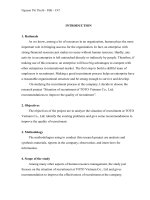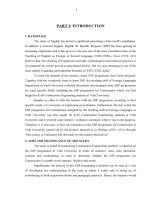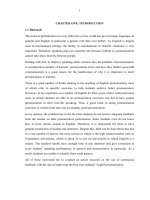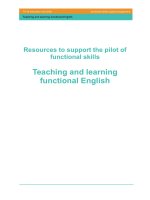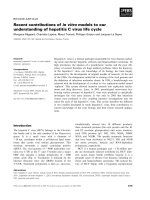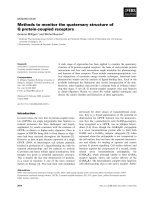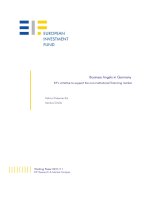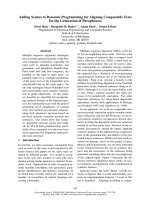Comodels engineering dynamic compositions of coupled models to support the simulation of complex systems
Bạn đang xem bản rút gọn của tài liệu. Xem và tải ngay bản đầy đủ của tài liệu tại đây (4.66 MB, 139 trang )
Pierre and Marie Curie University
Can Tho University
Doctoral School EDITE de Paris
UMMISCO/IRD
INTEGRATING COGNITIVE MODELS OF HUMAN
DECISION-MAKING IN AGENT-BASED MODELS: AN
APPLICATION TO LAND USE PLANNING UNDER
CLIMATE CHANGE IN THE MEKONG RIVER DELTA
By Quang Chi TRUONG
Doctoral thesis of Informatics - Complex Systems Modeling
Under the direction of:
Mr. Alexis DROGOUL (Director)
Mr. Minh Quang VO (Co-director)
Presented and publicly defended on 07/12/2016 before the examining committee:
Mme. Amal EL FALLAH SEGHROUCHNI, Professor, UPMC (Jury president)
Mr. Jean-Christophe CASTELLA, Senior researcher, CIRAD (Reviewer)
Mr. Dominique LONGIN, Researcher, CNRS/IRIT (Reviewer)
Mr. Frédéric ROUSSEAUX, Assoc. Professor, University of La Rochelle (Examiner)
Mr. Alexis DROGOUL, Senior researcher, UMI 209 UMMISCO, IRD (Thesis director)
Mr. Minh Quang VO, Assoc. Professor, Can Tho University (Thesis co-director)
RẫSUMẫ
Titre de la thốse en franỗais : Intộgration de modốles cognitifs de la prise de décision
humaine dans les modèles à base d'agent : application à la planification de l’utilisation du sol
dans le Delta du Mékong en tenant compte du changement climatique.
Auteur : Quang Chi TRUONG
Directeur de thèse : M. Alexis DROGOUL
Co-directeur de thèse : M. Minh Quang VO
Encadrants : M. Benoit GAUDOU, M. Patrick TAILLANDIER et M. Trung Hieu
NGUYEN
Au Vietnam, l'aménagement du territoire agricole est une étape importante de la
planification gouvernementale. Les plans sont établis chaque dix ans sous l’égide de
l’Organisation des Nations unies pour l'alimentation et l'agriculture (FAO), et définissent en
même temps deux principaux objectifs : les types de culture qui doivent être développées en
priorité par les agriculteurs ; et les investissements en infrastructure à réaliser par les autorités.
Dans ce contexte, la précision de la planification est déterminante pour déterminer quelles
politiques publiques seront les plus appropriées. Cependant, concernant la dernière période de
planification (de 2000 à 2010) la comparaison entre ce que prévoyaient le plan en 2010 et les
cartes réelles d’occupation du sol la même année témoignent de profondes différences.
La raison principale de ce décalage entre planification et réalité n’est pas très claire,
mais nous faisons l’hypothèse dans ce travail qu’elle est liée à la complexité de la prise de
décision individuelle des agriculteurs. Les agriculteurs sont en effet ceux qui, en dernier
ressort, décident de l’usage final des parcelles agricoles. Et leurs comportements individuels
sont influencés par un ensemble de facteurs externes comme la planification, bien entendu,
mais aussi l’usage actuel des parcelles, certains facteurs socio-économiques et les
changements qui s’opèrent dans leur environnement immédiat (changement climatique,
montée et salinisation des eaux, etc.). En conséquence, ces comportements ne peuvent pas
être, encore, facilement représentés par les modèles prédictifs utilisés en planification (quand
ceux-ci les représentent). De nombreuses tentatives ont été faites, en particulier à l'aide
d'approches à base d'agents, pour modéliser plus finement les comportements des agriculteurs
et être ainsi capable de mieux planifier. Cependant, ces approches ont été limitées par des
choix de conception erronés ou par la puissance de calcul disponible. La représentation des
1
processus de prise de décisions reste ainsi encore très simple dans la plupart des modèles de
planification agraire.
L'objectif initial de cette thèse est d’apporter une solution à ce problème en proposant,
premièrement, une approche cognitive basée sur le paradigme appelé Belief-Desire-Intention
(BDI) pour représenter les processus de prise de décision des acteurs humains, et
deuxièmement, une validation de cette approche dans le contexte d’un modèle complet de
changement d’usage des sols dans lequel la plupart des facteurs cités ci-dessus sont également
simulés. Le résultat de ce travail est une approche générique qui a été validée sur un modèle
intégrant le changement d’usage des sols d'une région située dans le Delta du Mékong au
Vietnam. Nos contributions principales sont les suivantes :
Intégration d’une architecture BDI au sein d'une plateforme de modélisation à base
d'agents (GAMA) ;
Conception d’un cadre générique baptisé « Multi-Agent Based Land-Use Change »
(MAB-LUC) permettant de modéliser et de simuler les changements d’usage des sols en
prenant en compte les décisions des agriculteurs ;
Proposition d’une solution permettant d’intégrer et d’évaluer les facteurs socioéconomiques et environnementaux dans le cadre de la planification agraire et d’intégrer
MAB-LUC dans le processus existant proposé par la FAO.
Ce travail, au-delà du cas d’étude concernant le Delta du Mộkong, a enfin ộtộ conỗu de
faỗon gộnộrique afin que la méthodologie utilisée puisse être généralisée à la modélisation de
systèmes socio-écologiques où les facteurs humains doivent être représentés avec précision.
Mots clés : Aménagement du territoire, Modélisation à base d’agent, BDI,
Modélisation avec agents cognitifs, Décision humaine, MAB-LUC, Modélisation des
changements d’usage des sols, Modélisation de systèmes socio-environnementaux.
2
ABSTRACT
In Vietnam, land-use planning (LUP) is an important part of national public policies.
Decennial plans stipulate both how the land should be used by individuals, making the
implicit assumption that they will follow it, and which investments need to be undertaken by
authorities to support this use. A good accuracy of these plans is therefore essential to
establish correct public policies. However, as it has been the case for the period from 2000 to
2010, the actual land-use, which can be assessed by remote sensing technology or assessment
surveys, has been constantly at odds with the proposed plans, sometimes by an important
margin.
The main reason behind this discrepancy lies in the complexity of the decision-making
of farmers, who are the ones who ultimately decide how they will make use of their parcels.
The decision-making is an individual behavior, influenced by external factors like
institutional policies, land-cover and environmental changes, economic conditions or social
dynamics. Therefore, it cannot be easily represented in the predictive land-use models.
Several attempts which use agent-based modeling approaches (ABM) have been made in the
literature to simulate the decision-making of farmers. However, these approaches have been
systematically limited by design choice or by available computational capabilities. Therefore,
the represented decision-making processes are still very simple.
The initial goal of this thesis has been then to address this problem by proposing, on
one hand, a cognitive approach based on the Belief-Desire-Intention (BDI) paradigm to
represent the decision-making processes of human actors in agent-based models and, on the
second hand, a validation of this approach in a complete land-use change model in which
most of the factors cited above have also been simulated.
The outcome of this work is a generic approach, which has been validated in a
complex integrated land-use change model of a small region of the Vietnamese Mekong
Delta. Our main contributions have been:
The integration of the BDI architecture within an agent-based modeling platform
(GAMA);
The design of the Multi-Agent Based Land-Use Change (MAB-LUC) integrated
model that can take into account the farmers’ decision-making in the land-use change
processes;
3
The proposal of a solution to assess the socio-economic and environmental factors in
land-use planning and to integrate the MAB-LUC model into the land-use planning process
of.
I conclude by showing that this work, designed in a generic fashion, can be reused and
generalized for the modeling of complex socio-ecological systems where individual human
factors need to be represented accurately.
Keywords: Agent-based Modeling, BDI, Cognitive modeling, Human Decisionmaking, MAB-LUC, Land-use Change modeling, Land-use Planning, Socio-environmental
Modeling.
4
ACKNOWLEDGEMENTS
I would like to express here my sincere thanks to those who gave me their help and
who have contributed to the realization of this thesis.
First and foremost, my sincere thanks go to my supervisor, Prof. Alexis Drogoul at the
IRD and the University Pierre and Marie Curie (UPMC), France, for the continuous support
of my Ph.D study and related researches. His supervision, advice, guidance and suggestion
helped me in all the time of research and writing of this thesis and research papers. Without
his motivation and persistent help this dissertation would not have been possible.
Beside my supervisor, I express my grateful thanks to the co-supervisors Assoc. Prof.
Benoit Gaudou at the IRIT, University of Toulouse Capitole 1 and Assoc. Prof. Patrick
Taillandier at the IDEES, University of Rouen for their advice, suggestion, guidance and
correction of the thesis and research papers as well as their help for the implementation of the
BDI architecture into the GAMA platform.
I would like to express my gratitude to the rest of my thesis committee: my cosupervisors at the Can Tho University (CTU), Assoc. Prof. Vo Quang Minh and Assoc. Prof.
Nguyen Hieu Trung, for their helpful supervision and advice in my research in the specific
context in Vietnam and their encouragement in completing this study till the end.
The GAMA platform is an open source platform developed collaboratively by many
researchers. One part in Chapter 4 of my thesis is the result of this collaborative work. Thus, I
am extremely thankful to the GAMA developers, especially the BDI plug-in developers:
Assoc. Prof. Philippe Caillou from LRI, University Paris Sud; Mr. Mathieu Bourgais from
IDEES and Assoc. Prof. Carole Adam from the University of Grenoble for their works in
implementing the plug-in and for giving me a great chance to participate in this work.
This joint doctoral thesis between the UPMC and the CTU has received specific and
careful administrative help from both universities. First, I would like to thank Ms. Patricia
Zizzo for her help for administrative points at the UPMC. At the CTU side, I would like to
express my gratitude to the particular interest and support of the rector board of the CTU:
Assoc. Prof. Le Viet Dung, Prof. Nguyen Thanh Phuong, the vice rectors of the CTU. I would
like to thank also the Graduate School and the College of Environment and Natural Resources
of the CTU, especially Assoc. Prof. Mai Van Nam, Assoc. Prof. Nguyen Hieu Trung, Prof. Le
Quang Tri, Dr. Nguyen Xuan Hoang, Dr. Ngo Thuy Diem Trang, Ms. Nguyen Huu Giao Tien
5
and Ms. Bui Thi Chuyen, without their strong support this complicated paperwork for the
joint doctoral thesis between the UPMC and the CTU could not be signed.
I would like to express my gratitude to the PDI-MSC Scholarship program from the
IRD and the UPMC for providing a postgraduate scholarship for me to conduct my research.
The chance to do my PhD research in the IRD and the UPMC has been one of the most
valuable opportunities in my career and I therefore feel grateful to all the professors of the
UMMISCO, the IRD, the UPMC and the doctoral school (EDITE), who provided me with
necessary related courses for my research. It is with immense gratitude that I acknowledge the
support and help of the program organizers, Prof. Jean-Daniel Zucker, Prof. Christophe
Cambier, Dr. Nicolas Marilleau and Ms. Kathy Baumont, during my visiting times in the IRD
– Bondy, France.
I would like also to thank the projects DREAM, PEERS-CLIMATIC and ARCHIVES,
funded by the IRD, where I benefited the budget for my four visiting times in UPMC, France
during my thesis.
I would thank the ICT Lab’s members of the University of Sciences and Technology
of Hanoi for their warm welcome during the period of writing this thesis. I would like to say a
really big thank you to Dr. Lai Hien Phuong who has taken a lot of times to review the
manuscript. I also thank my friends and colleagues Dr. Truong Xuan Viet, Dr. Truong Minh
Thai and specifically my PhD colleague Mr. Huynh Quang Nghi, for their suggestion for my
research and for their help with GAMA simulation platform.
The collected data of the thesis are supported by the provincial level project
coordinated by Prof. Vo Thi Guong, College of Agricultural and Applied Biology, the CTU;
the help from Ms. Tran Thi Hien, the DONRE of the Ben Tre province and the alternative
collection of data by my colleagues at CENRES, Dr. Vo Quoc Tuan, Ms. Tran Thi Ngoc
Trinh, Ms. Nguyen Thi Ha Mi and Mr. Cao Quoc Dat. I would like to thank them all for their
help.
Last but not the least, I would like to give my gratitude to my mother, my parents-inlaw and my brothers and sisters who always encourage me during a long period of this study.
On a personal note, I appreciate the sacrifices made by my wife, Hong Thao, to help me
through this journey. Without her unconditional love and patient support during this period,
this thesis would not be completed. And to my lovely daughter Thao Phuong, my son Quang
Phu, with all my heart.
6
TABLE OF CONTENTS
RÉSUMÉ .................................................................................................................................... 1
ABSTRACT ............................................................................................................................... 3
ACKNOWLEDGEMENTS ....................................................................................................... 5
TABLE OF CONTENTS ........................................................................................................... 7
LIST OF FIGURES .................................................................................................................. 12
LIST OF TABLES ................................................................................................................... 15
CHAPTER 1
INTRODUCTION ............................................................................... 16
1.1
Agricultural Land-Use Planning in Vietnam ............................................................. 16
1.2
Anlyzis of the recent land-use plans issues in the Mekong Delta ............................. 18
1.3
Research questions .................................................................................................... 22
1.4
Objectives of the current research ............................................................................. 22
1.5
Contribution of the thesis .......................................................................................... 23
1.6
Structure of the thesis ................................................................................................ 24
CHAPTER 2
2.1
STATE OF THE ART ......................................................................... 26
Land-use and land-cover change models................................................................... 26
2.1.1
Descriptive and explicative models.................................................................... 26
2.1.2
Bridging the gap: toward hybrid models ............................................................ 27
2.2
Decision-making of farmers concerning land-use change ........................................ 29
2.3
Brief introduction to decision-making in socio-ecological systems .......................... 31
2.3.1
Decision-making approaches for reactive agents ............................................... 31
2.3.2
Decision-making approaches for cognitive agents ............................................. 33
2.4
Agent architectures embedding decision-making processes ..................................... 35
2.4.1
Cognitive agent architectures ............................................................................. 35
2.4.2
BDI architectures................................................................................................ 36
2.5
BDI architectures and platforms to simulate farmer behaviors ................................. 40
2.5.1
Agent architectures for representing farmer behaviors ...................................... 40
7
2.5.2
2.6
BDI architecture in existing ABM platforms ..................................................... 41
Conclusion ................................................................................................................. 43
CHAPTER 3
THE BASIC MULTI-AGENT BASED MODEL OF LAND-USE
CHANGE (MAB-LUC) ........................................................................................................... 44
3.1
Basic integrated model for the land-use change ........................................................ 44
3.1.1
The conceptual model of the MAB-LUC ........................................................... 45
3.1.2
Modularity of the MAB-LUC ............................................................................ 46
3.2
Definition of the MAB-LUC ..................................................................................... 48
3.2.1
Economic Sub-model ......................................................................................... 49
3.2.2
Environmental sub-model .................................................................................. 52
3.2.3
Sub-model of farmers’ social influence ............................................................. 56
3.2.4
Farmer sub-model .............................................................................................. 57
3.2.5
Discussion about the farmer decision-making agent.......................................... 64
3.3
Conclusion ................................................................................................................. 65
CHAPTER 4
INTEGRATING A HUMAN DECISION-MAKING MODEL INTO
AN AGENT BASED MODEL ................................................................................................ 66
4.1
Principles of the human decision-making architecture.............................................. 67
4.2
Presentation of the GAMA BDI plug-in.................................................................... 69
4.2.1
Representation of knowledge of GAMA BDI agents ........................................ 70
4.2.1.1 Declaration of a BDI agent................................................................................. 70
4.2.1.2 Predicates ........................................................................................................... 70
4.2.2
4.3
Behavior of agents .............................................................................................. 73
Integrating the BDI architecture into the sub-model of Farmers............................... 74
4.3.1
Conceptual model of the farmers based on the BDI architecture ...................... 75
4.3.2
Desires base of farmers ...................................................................................... 76
4.3.3
Intentions base of farmers .................................................................................. 78
4.3.4
Set of plans defined for farmers ......................................................................... 78
4.4
Conclusion ................................................................................................................. 80
8
CHAPTER 5
VALIDATION OF THE COGNITIVE AGENT IN LAND-USE
CHANGE MODELS 82
5.1
Description of experiments ........................................................................................ 82
5.1.1
Experiment data.................................................................................................. 82
5.1.2
Indicators for simulation assessment.................................................................. 84
5.2
Calibration of the sub-model of the MAB-LUC ....................................................... 86
5.2.1
Calibration of the model of farmers using Markov-based decision approach ... 86
5.2.2
Calibration of the model of farmers using MCDM approach ............................ 87
5.2.3
Calibration of the model of Farmers using the BDI-based decision approach .. 87
5.3
Evaluation the MAB-LUC......................................................................................... 88
5.3.1
Experiment 1: The MAB-LUC using Markov-based decision approach ........... 88
5.3.2
Experiment 2: The MAB-LUC using the MCDM approach............................. 91
5.3.3
Experiment 3: The MAB-LUC model using the BDI - based decision approach.
.................................................................................................................. 94
5.4
Assessment ................................................................................................................ 98
5.5
Conclusion ............................................................................................................... 100
CHAPTER 6
INTEGRATION OF THE LAND-USE CHANGE MODEL INTO
THE LAND-USE PLANNING PROCESS ........................................................................... 101
6.1
Integration of the MAB-LUC into the land-use planning process .......................... 101
6.2
Appraisal of socio-economic factors for land-use plans ......................................... 103
6.3
Appraisal of both socio-economic and environmental factors for land-use plans .. 106
6.4
Assessment of land-use plans under climate change ............................................... 108
6.5
Conclusion ............................................................................................................... 110
CHAPTER 7
7.1
CONCLUSION ................................................................................. 111
Contributions ........................................................................................................... 111
7.1.1
Contributions to agent-based modeling............................................................ 111
7.1.2
Contributions for LUCC, LUP and assessment on impact of climate change . 111
7.2
Perspectives ............................................................................................................. 112
7.2.1
Improving the integrated model regarding the usage of uncertain data ........... 112
9
7.2.2
Extending the integrated model to similar works............................................. 112
A
APPENDIX A: GLOSSARY ............................................................................... 116
B
APPENDIX B: PUBLICATIONS ....................................................................... 119
REFERENCES ....................................................................................................................... 120
10
LIST OF ACRONYMS
Abbreviation
ABM
ADP
AHP
BDI
CA
DARD
DONRE
FAO
GAMA
GAML
GIS
LS
LUC
LUCC
LUP
MAB-LUC
MCDA
MCDM
MONRE
PRS
RCT
SLR
TBR
TPB
UML
VGSO
Description
Agent-Based Modeling
Absolute Deviation Percentage
Analytic Hierarchy Process
Belief – Desire – Intention
Cellular Automata
Department of Agriculture and Rural Development
Department of Natural Resources and Environment of the Socialist
Republic of Vietnam
Food and Agriculture Organization
GIS & Agent-based Modeling Architecture modeling platform
GAMA language
Geographic Information Systems
Land suitability
Land-Use Change
Land-use and land cover change
Land-Use Planning
Multi-Agent Based model for Land-Use Change
Multi-Criteria Decision Analysis
Multi-Criteria Decision Making
Ministry of Natural Resources and Environment of the Socialist
Republic of Vietnam
Procedural Reasoning Systems
Rational Choice Theory
Sea Level Rise
Theory of Bounded Rationality
Theory of Planned Behavior
Unified Modeling Language
Vietnamese General Statistics Office
11
LIST OF FIGURES
Figure 1. The main steps of the Land-Use Planning process (Source: (FAO, 1993)) ............ 17
Figure 2. Land-use area in the Mekong Delta in 2000 and in 2011. ....................................... 19
Figure 3. Comparison between the planned and the actual land-use of Ben Tre province ..... 19
Figure 4. Maps of the five villages of Thanh Phu district in the Mekong Delta. ..................... 20
Figure 5.
Comparison of planned land-use map and actual land-use map in 2010 for five
villages of Thanh Phu district, Ben Tre province. (1) Land-use planning map 2010 (planned
in 2001), (4) Land-use planning map 2010 (modified in 2005), (2)(5) Land-use map in 2010,
(3) Fuzzy Kappa map between 1 and 2, (6) Fuzzy Kappa map between 4 and 5..................... 21
Figure 6. Farmers’ choices for land-use change .................................................................... 22
Figure 7. A simple two-state of Markov chain ........................................................................ 32
Figure 8. Theory of planned behavior ...................................................................................... 34
Figure 9. The Procedural Reasoning System ........................................................................... 37
Figure 10. The BDI4JADE architecture ................................................................................... 38
Figure 11. Jadex abstract architecture .................................................................................... 39
Figure 12. UML class diagram of the conceptual model of the MAB-LUC ............................. 46
Figure 13. Conceptual view of the MAB-LUC ......................................................................... 47
Figure 14. Mathematical models for simulating the price and cost of products. ..................... 49
Figure 15. UML diagram of market price economic models ................................................... 50
Figure 16. Market prices of the most popular products in the Mekong Delta from 2005 to
2010. ......................................................................................................................................... 50
Figure 17. Benefit of different land-use types in the Mekong Delta from 2005 to 2010 .......... 51
Figure 18. Conceptual model of environmental sub-model ..................................................... 53
Figure 19. The UML diagram of the environmental sub-model ............................................... 53
Figure 20. Spatial data for the land suitability model: (1) Soil salinity map in 2005, (2)
Regions protected by dikes and sluices in 2010, (3) Soil salinity map in 2010. ...................... 56
Figure 21. The conceptual model of farmers............................................................................ 58
12
Figure 22. Land-use map of five villages (An Thanh, Binh Thanh, An Thuan, An Quy, An
Nhon, An Dien) of Thanh Phu district in 2005. ....................................................................... 59
Figure 23. Activity diagram for the land-use selection with Markov-based decision .............. 61
Figure 24. UML diagram of the farmer agent based on MCDM. ............................................ 62
Figure 25. Human decision-making agent framework for social environment model ............. 68
Figure 26. UML class diagram of the BDI farmer sub-model ................................................. 75
Figure 27. Activity diagram when farmers change to a highest income land-use type............ 79
Figure 28. Activity diagram when farmers imitate their neighbors ......................................... 79
Figure 29. Activity diagram of the plan “loan_from_bank” of farmers .................................. 80
Figure 30. Land-use map in 2005 of 5 villages of Thanh Phu district. .................................... 83
Figure 31. Land-use map in 2010 of five villages of Thanh Phu district. ................................ 84
Figure 32. Fuzzy Kappa calculation ........................................................................................ 85
Figure 33. An example on the issue of Kappa and Fuzzy Kappa indicators. ........................... 85
Figure 34. The simulation result in 2010 of MAB-LUC using the Markov-based decision
approach................................................................................................................................... 90
Figure 35. The Fuzzy map of the farmer’s decision making using the Markov decision
approach................................................................................................................................... 91
Figure 36. Simulation results of the MCDM approach in 2010. .............................................. 92
Figure 37. The Fuzzy Kappa map of the MAB-LUC using the MCDM approach. .................. 94
Figure 38. Simulation results of the BDI-based decision approach over 5 years. ................... 95
Figure 39. Chart representing the number of farmers corresponding to each desire. ............ 97
Figure 40. Fuzzy Kappa map of the MAB-LUC model using the BDI-based decision approach.
.................................................................................................................................................. 98
Figure 41. Comparison of farmer decision making approaches using one-way ANOVA with
SPSS statistics. ......................................................................................................................... 99
Figure 42. LUP process with MAB-LUC framework ............................................................. 102
Figure 43. Simulated maps in 2020 with different loan policies. ........................................... 104
Figure 44. Area of land-use types according to different credit policies in 2020 .................. 105
Figure 45. Desires of farmers according to different credit policies in 2020 ........................ 105
13
Figure 46. A scenario of changing soil salinities of the region.............................................. 106
Figure 47. Area of land-use types in 2020 according to the scenario 2 ................................ 107
Figure 48. Desires of farmers in 2020 according to the scenario 2....................................... 107
Figure 49. Assessment of land-use plans under SLR scenarios ............................................. 109
Figure 50. Shrimp-mangroves systems in the Mekong Delta ................................................. 114
14
LIST OF TABLES
Table 1. Classification of cognitive agent architectures .......................................................... 36
Table 2. CPI of Vietnam from 2005 to 2010 ............................................................................ 51
Table 3. Markov matrix ............................................................................................................ 60
Table 4. The difficulty matrix when shifting from a land-use to the others land-use types .... 64
Table 5. Beliefs base of farmers and conditions for the update_beliefs function .................... 76
Table 6. Relationships between Beliefs and Desires for farmers agents ................................. 76
Table 7. Input data for each sub-model of the land-use change model and the corresponding
years used in our experiments. ................................................................................................. 83
Table 8. Markov matrixes representing the transition among land-use types ......................... 89
Table 9. Area of the land-use types from 2005 to 2010 simulated with the MCDM approach 93
Table 10. Area of the land-use types from 2006 to 2010 simulated with the BDI - based
decision approach .................................................................................................................... 96
15
CHAPTER 1 INTRODUCTION
This chapter presents the context of this thesis. In particular, I introduce the Land-Use
Planning (LUP) domain and show its important role in the socio-economic development of
Vietnam. I also introduce the main difficulties in LUP that are due to the fact that the planned
land-use solutions are not performed as expected. These challenges lead to the objective of
my thesis in which I have investigated and proposed a new way to support planners in
building land-use plans.
1.1 Agricultural Land-Use Planning in Vietnam
Agriculture and aquaculture are the main economic activities of Vietnamese people
(46.3% of population - (VGSO, 2015)). Thus, Land-Use Planning (LUP) in agriculture
(including aquaculture) is an important part of the national public policies that define the
socio-economic development orientations. The land-use plans are built based on the
Vietnamese government objectives in terms of socio-economic development for the next 10
years for the three main administrative levels in Vietnam (province or municipality1, district
and commune). After 5 years, the land-use is reviewed and compared with the plan; the plan
is then updated in consequence.
The design of these land-use plans by the Vietnamese government is driven by general
rules defined in the Law on Land (VNA, 2003, 2013) and by more precise guides from the
Ministry of Natural Resources and Environment of Vietnam (MONRE, 2009b, 2014). These
official rules provide only the general guidelines and requirements for the plans. Concerning
the technical aspects of the plans, planners apply the process guide from the Food and
Agriculture Organization (FAO) for land-use planning support (FAO, 1993). The LUP
process of FAO is composed of 10 successive steps (cf. Figure 1). Most of them (steps
number 1, 3, 5, 6, 7) require planners’ decision-making.
1
The five main municipalities (Ha Noi, Ho Chi Minh City, Hai Phong, Da Nang and Can Tho) have the same
administrative level as the provinces.
16
Figure 1. The main steps of the Land-Use Planning process (Source: (FAO, 1993))
Steps 5 and 6 are the most important ones in the FAO process. Step 5 consists in
assessing the suitability of the land according to its planned land-use type. The main analysis
criteria focus on natural conditions such as the soil type, the water quality and the level of
floods. The results of the fifth step show which land-use types are suitable for each land unit.
These land suitability results are not enough to determine the land-use plans because the
produced alternatives do not take into account social, economic and environmental factors.
This appraisal is done in the sixth step: the FAO guideline shows which activity should be
installed on each land unit and the activity is assessed from an environmental point of view.
The economic assessment takes into account both the investment of the government and the
income of farmers.
FAO provides also a specific guideline for land evaluation (FAO, 1981) in order to
support the land suitability evaluation in the 5th step. Many studies have simply applied the
guidelines of FAO for land evaluation (Kauzeni, Kikula, Mohamed, Lyimo, & Dalal-Clayton,
1993; Kutter, Nachtergaele, & Verheye, 1997) or modified the land suitability assessment by
using a Multi-Criteria Decision Analysis (Kalogirou, 2002; Chandio, Matori, Yusof, Talpur,
& Aminu, 2014; Vu et al., 2014). These studies mainly concentrate on the fifth step of the
LUP process.
17
Other studies in the literature have concerned the sixth step. Trung et al. (2006)
proposed to take into account the socio-economic and environmental factors, which mainly
focus on the gross income, investment costs and labor’s day requirement. Tri et al., (2013)
optimized the capital, labors and incomes in the elicitation of potential scenarios. Following
the same approach, Gowing et al., (2006) assessed social and environmental factors. In this
study, the assessment of the social factor concerns the change of cropping of farmers and their
strategy to adapt to the change of salinity of water. These studies only focus on a subpart of
Step 6 of the LUP process. They enric the plan assessment but they do not take into account
the social aspects of farmers behaviors, which happen to strongly impact land-use plans.
In summary, none of the previous studies have proposed a dynamic appraisal of the
socio-economic and environmental factors, whereas it is mandatory to understand and predict
land use changes for an efficient planning. Why it is mandatory will be better understood by
reading the next section, which analyses the issues of recent land-use plans for the area of the
Mekong Delta, Vietnam.
1.2 Anlyzis of the recent land-use plans issues in the Mekong Delta
The region of the Vietnamese Mekong Delta (VMD), which is composed of 13
provinces including a municipality and is home of approximately 18 million of inhabitants,
was by far the most productive region of Vietnam in agriculture and aquaculture in 2014. In
terms of rice production, for instance, 47% of the cultivated areas in Vietnam were situated in
the VMD, and they outputted 54% of the total production; in terms of aquaculture, 2/3 of the
Vietnamese production originated from the VMD. According to (Young, Wailes, Cramer, &
Khiem, 2002), these performances, which have roughly tripled in the last 30 years in all
sectors, have fueled the boom of the Vietnamese exports of agricultural products (especially
rice, shrimps and fruits). This spectacular rise is due to a number of factors: a better economic
environment (thanks to reforms more favorable to the private sector), the adoption of modern
techniques (fertilizers, mechanical harvesting and progresses in aquaculture), yield
improvements, improved irrigation and drainage, among others.
Regarding the statistical data on land-use of the Mekong Delta during the period 20002011 (Figure 2), it is easy to see that it has had a trend to shift from rice to shrimps. The
surface dedicated to rice crops has strongly decreased (more than 170,000 ha) while the one
dedicated to shrimp aquaculture has doubled from 229,350ha to 489,220ha. Young et al.
(2002) showed that in early 2000 the market price of rice was near or below the production
cost, which explains that a majority of farmers have shifted their land-use away from rice.
18
(Source: Vietnamese General Statistics Office (VGSO, 2000) and Ministry of Natural
Resources and Environment of Vietnam (MONRE, 2012))
Figure 2. Land-use area in the Mekong Delta in 2000 and in 2011.
This trend of land-use changes can also be observed at the province level. For
example, the land-use plan of Ben Tre province (Figure 3) predicted an increase of the
aquaculture area in 2010. However, the comparison of the plan with the observed land-use in
2011 shows that a total cultivated area of 175,824ha was planned, where in fact it reached
179,671ha. These values (which gather all kinds of agricultural activities) do not seem so
significant at the macro-level, but profound divergences can be unveiled when studying the
situation in more detail, in particular the deviation of the cultivated area for each activity. For
example, the rice area increased to 38,000ha but was planned to be only 30,000ha (+ 27%);
the surface devoted to aquaculture, which was supposed to reach 39,200ha, only reached
30,289ha (-23%); finally the forest area, which was expected to cover 350ha (PCBT, 2011),
remained at 1.30ha.
(Source: PCBT, 2011)
Figure 3. Comparison between the planned and the actual land-use of Ben Tre province
19
(Source: Combination of data from the Land resource department, Can Tho University,
Vietnam (Vo, Q. M. and Le, Q. T., 2006) and the Department of Environmental and Natural
resources of Ben Tre province, Vietnam (PCBT, 2011) )
Figure 4. Maps of the five villages of Thanh Phu district in the Mekong Delta.
To understand these shifts, let us consider more specifically five villages situated in
the middle of Thanh Phu district in Ben Tre province (Figure 4). They have been chosen
because they exhibit a huge variety of land-use while remaining geographically close enough
to allow considering that the farmers living in these villages share common "cultural traits"
and traditions. Figure 5 shows the results of a spatial comparison I conducted on these 5
villages in order to evaluate the shift of land-use between, on one hand, the two projections
for the year 2010 of the plans produced in 2000 and 2005 and, on the other hand, the actual
land-use map in 2010 (PCBT, 2011). Changes are measured using the Fuzzy Kappa indicator
(Visser & de Nijs, 2006), a variant of the Kappa indicator (J. Cohen, 1960) that provides a
fuzzy distance measure close to how humans compare maps. The darkness of the areas in
maps 3 and 6 in Figure 5 is proportional to the land-use difference. We can observe that,
although the average shift for the whole province is not huge, the local changes show a
complete change of productions on the whole territory. The plan published in 2000 is
completely different to the land-use in 2010 (almost all parcels have changed) and the
rectified plan published in 2005, although it corrects some errors, completely misses the shifts
in two villages and along the canals.
20
Figure 5. Comparison of planned land-use map and actual land-use map in 2010 for
five villages of Thanh Phu district, Ben Tre province. (1) Land-use planning map 2010
(planned in 2001), (4) Land-use planning map 2010 (modified in 2005), (2)(5) Land-use map
in 2010, (3) Fuzzy Kappa map between 1 and 2, (6) Fuzzy Kappa map between 4 and 5.
Note that the environmental conditions have almost not been changed during these years. We
can see that, even in this favorable situation, land-use planning does not give a good result.
This error can be explained by the human factors involved in land-use change. In order to
better understand this factor, we conducted an interview with 25 farmers in Binh Thanh
village of Thanh Phu district, Ben Tre province. The interviewees were selected among the
farmers who have changed their land-use at least once until 2014 (some of them have changed
their land-use many times). The goal of these interviews was to identify the reasons why these
farmers decided to change. Figure 6 shows seven reasons that have been expressed. The five
main ones are: following neighbors (nearly a third), seeking high benefit (a quarter), because
of the suitability of parcels (21.43%), to follow tradition (12.5%) and finally because of price
drops (7%)
21
Figure 6. Farmers’ choices for land-use change
To conclude, the analysis of the predicted land-use plans of Thanh Phu district
highlights a lack of efficient tools and methods in existing planning decision-support systems,
especially ones able to take human factors into account. I argue that this lack is the main
reason for the discrepancy in terms of land-use between the predicted plan and the actual
world, because farmers have the ultimate choice on how they use their parcels.
1.3 Research questions
The example presented above on a particular case study raises a more global question
related to the support of building a land-use plan where human being’s decisions play a key
role in the evolution of the territory. The main question of this thesis can thus be expressed as
follows: how to build a land-use plan taking into account individual human decisions in the
context of land-use change?
To answer this question, I propose an integrated model that combines quantitative and
qualitative data and that can represent the complexity of farmers’ behaviors (and decisionmaking process) in order to build and test realistic scenarios of land-use changes.
1.4 Objectives of the current research
Derived directly from this research question, my thesis has four objectives:
The first one focuses on the integration, within an agent-based simulation platform, of
an architecture able to better represent human decision-making processes. This architecture is
generic and has been tested on the modeling of the farmers’ decision-making process
concerning their parcel land-use.
22
The second objective concentrates on the design and implementation of an agentbased model of land-use change, integrating quantitative and qualitative data. It contains
agents representing human beings in order to take into account the complexity of the farmers’
decision-making process within a rich and complex environment.
The third objective is to simulate the land-use change in the Mekong Delta (more
specifically in the Ben Tre province) and to validate the capacities of the proposed model with
real data.
Finally, simulations with various scenarios have been carried out to illustrate the
genericity of the architecture and of the model. This aims at showing its applicability for landuse change planning in supporting the 6th step of the land-use planning process of FAO.
1.5 Contribution of the thesis
The main contribution of this thesis is a generic framework integrating human decisionmaking in socio-environmental modeling. The framework is based on the use of the classical
BDI (Belief – Desire -
Intention,
Bratman, 1987) paradigm to define the cognitive
architecture of socio-environmental actors. The framework is integrated into an agent-based
platform (GAMA2, Grignard et al., 2013 ). The platform provides modelers with a dedicated
modeling language (GAML) easing the development of any kind of agent-based models even
by non-computer scientists. We have extended the platform and provided extensions in the
GAML language to allow the design, implementation and integration into a socioenvironmental model of cognitive agents based on a BDI architecture.
A strength of this work is to be grounded on a concrete and important application. The
second contribution is thus an application-oriented approach. This work is able to provide, on
a part of the Ben Tre province, a model reproducing the land-use change which was validated
with actual data. However, the approach is fully generic and can be applied on other case
studies.
The framework and the implemented model promise to be a helpful tool for planners
and people in the environment field.
2
GAMA website:
23
1.6 Structure of the thesis
The next chapters of this thesis are organized as follows:
In chapter 2, I propose a brief state of the art of existing land-use change models. I
show that human behaviors and decision-making processes are not really well taken into
account in these models and how this restricts their relevance. I then explore some basic
theories of human behavior modelling that could be used for this purpose in a land-use change
model. In particular, I take a closer look at the BDI architecture that fulfils most of my
requirements.
In chapter 3, I show that a complex architecture like BDI is actually required to
represent the farmers’ behaviors. To this purpose, I introduce a modular agent-based model of
land-use change, in which these behaviors can be represented using different architectures
(Markov-based or multi-criteria selection). This presentation allows me to also introduce the
different components of the model and the data sources I have used throughout the thesis,
including the results of surveys conducted with farmers.
One of the problems a modeler might face is that BDI is not commonly used to
simulate socio-environmental systems. Therefore, beside simple or ad-hoc solutions, few
existing implementations in GAMA can simultaneously support the representation of complex
data (with thousands of agents) and the modeling of complex behaviors. Chapter 4 describes
how I have integrated a BDI architecture into the GAMA simulation platform in order to
benefit from its spatial explicit/multi-modeling/multi-scale underpinnings.
In chapter 5, I validate the relevance of the BDI architecture in representing the
farmers’ behaviors in land-use change models. A real dataset (taken from a coastal district of
the Mekong Delta) is used to calibrate the different sub-models and to validate their outputs.
The comparison of my 3 implemented behavioral models (Markov-based decision, multicriteria decision-making and BDI-based decision) shows that the BDI architecture allows to
produce more realistic outcomes.
One of the main difficulties of the FAO land-use planning process (see Figure 1) is to
be able to assess the future impacts of alternative options or land-use policies, which
corresponds to the 6th step of the process. Based on the results obtained in Chapter 5, I explore
in Chapter 6 how our model could be used to perform this assessment and show two examples
of this use: the first one tests various economic policies regarding the access of farmers to
credit, the second takes into account the construction of infrastructures such as salt water
sluice gates to change the environmental conditions.
24

